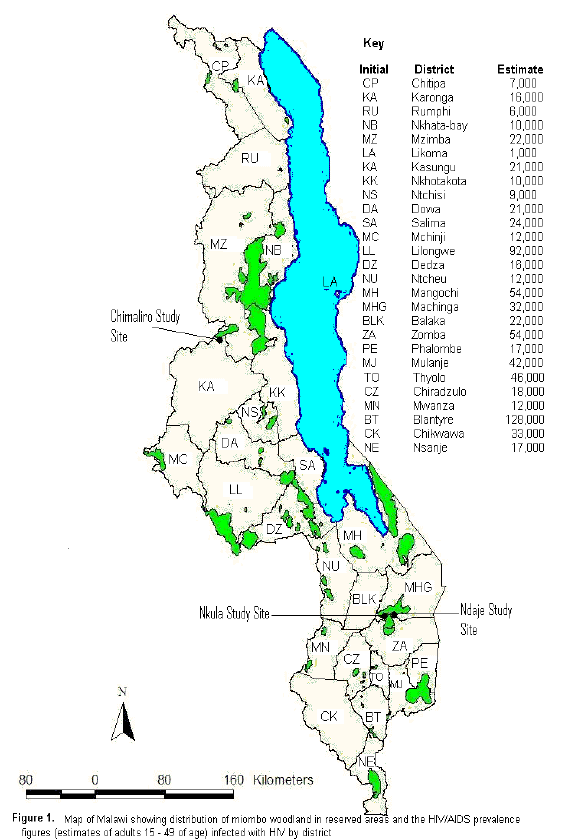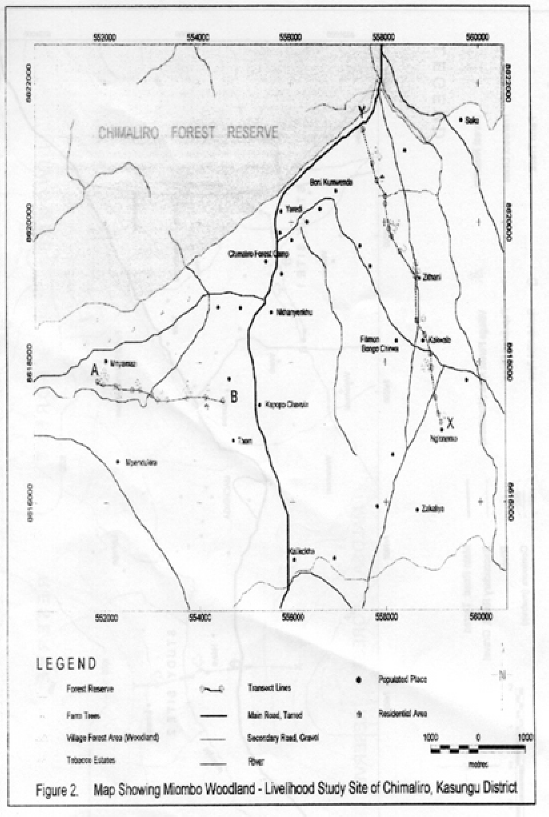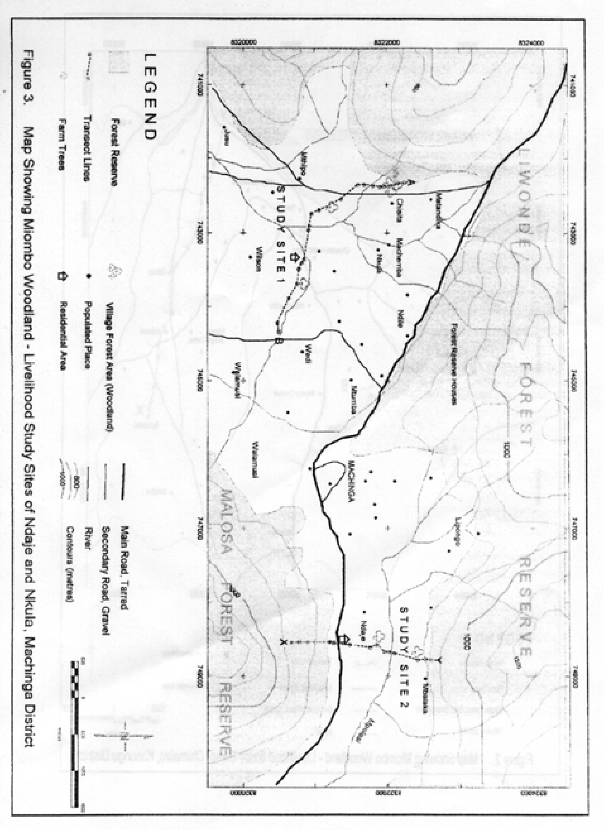


The study is exploratory since proxy indicators were used to identify HIV/AIDS-affected households. Due to the sensitivity surrounding the pandemic, where households or individuals do not freely admit to having HIV/AIDS, no attempt was made to verify the reasons for illness and death identified by the proxy indicators.
Current national forest policy aims at bringing management of state forests, at least those closest to the people, under co-management. The most revealing comparison to study the current and potential responses of the woodlands as a safety net vis-à-vis their response sustainability was that between co-managed areas (i.e. Ndaje in Machinga District and Chimaliro in Kasungu District) and those under total community control under customary land (i.e. Nkula in Machinga District) (Figure 1). The latter study site is also situated, although not too far away from the Liwonde Forest Reserve, where access is rather more restrained by standing decrees.
Due to the nature of the pandemic and the urgency of identifying and sharing existing community response mechanisms, a comparative case study approach was undertaken. The three case study sites were also identified to enable a comparison between areas of varying HIV/AIDS infection rate and varying woodland tenurial and access regimes (Table 1). The Chimaliro co-management site in Kasungu is considered a low impact area (with an estimated HIV/AIDS prevalence rate of 6.7 percent) while the two co-management and customary land sites in Machinga represented medium to high HIV/AIDS impact areas (with a HIV/AIDS prevalence rate of 17 percent) (GoM, 2003).

Table 1: Sites used in the study
Woodland tenurial and access regime |
Incidence/Prevalence of HIV/AIDS | |
High |
Low | |
State Forest (Reserve) under co-management |
Ndaje, Liwonde Forest Reserve (Machinga District) |
Chimaliro, Chimaliro Forest Reserve (Kasungu, District) |
Customary land |
Nkula (Machinga District) |
|
Estimated HIV/AIDS prevalence rate |
17 % |
6.7 % |
The Chimaliro co-management site (Figure 2) is in Group Village Headmen Boni Chakuchanya and N'gonomo in the area of Traditional Authority Kaluluma, located 57 km north of Kasungu District Headquarters and approximately midway between the capital city, Lilongwe, about 180 km away, and the city of Mzuzu, in the northern region. It forms the northern boundary of the extensive Lilongwe-Kasungu plain that lies at approximately 1100 m.a.s.l. It has, on average, a population density of over 74 persons/km2 (NSO, 1998). The area receives mean annual rainfall of between 800 and 1600 mm. Mean annual temperature ranges from a maximum of 22 - 240C to a minimum of 12 - 140C.
The Machinga study sites (Figure 3) of Ndaje Co-management and Nkula Customary land, with a population density of over 98 persons/km2 (1998), are in Group Village Headmen Ndaje and Nkula, respectively, in Traditional Authority Sitola. The specific villages under co-management included Ndaje, M'balaka and Lipongo, situated around the Machinga District Headquarters, while those under customary controls in Group Village Headman Nkula included Mthipo and Wilson villages. The latter villages are about 3-5 km from Machinga District Headquarters. Ndaje, M'balaka and Lipongo villages are sandwiched between Malosa and Liwonde Forest Reserves, and there is little land for expansion for cultivation and settlement.
The intention to hold focus group discussions by using participatory gathering tools in each community was to identify key forest products used by each group, the key opportunities perceived by the different groups with regard to access and use of the forest, the main threats to the resources in the areas of different HIV/AIDS prevalence, and what recommendations are to be made to ensure that the resources are sustained in a manner that provides safety nets to households for many years to come. Incorporating gender and age differentiated groupings, including HIV/AIDS-affected and child-headed households, three social groups participated in the discussions and these were male and female adults and the youth. However, due to limited time and the fact that the interviews were being held at the beginning of the rainy season, which is a peak period for farming activities when the youth are actively involved, it was only possible to hold focus group discussions involving the youth in Ndaje co-management site and not in the other two study sites. For the same reasons, discussions involving each social group involved pooling men and women from all the villages under each study site, i.e. Ndaje, M'balaka and Lipongo villages under Ndaje co-management site, Mnyamazi, Chipeni, Thomu, Zithani, Mphandukira and Ng'onomo villages under Chimaliro co-management site and Mthipo and Wilson villages under Nkula customary land site (Table 2).


Table 2: Attendance during Focus Group Discussions (FGDs)
Study site villages |
Social group |
Total | ||
Male adults |
Female adults |
Youth | ||
Mthipo/Wilson (Nkula customary)) |
13 |
25 |
- |
38 |
Ndaje/M'balaka/Lipongo (Ndaje co-management) |
27 |
23 |
23 (20 boys & 3 girls) |
63 |
Ng'onomo/Mnyamazi (Chimaliro co-management) |
22 |
26 |
- |
48 |
Total |
62 |
74 |
23 |
149 |
In conjunction with the VNRMC a transect walk was conducted through each study area, in line with each committee's perceived priorities, in order to describe the general forest status, the abundant, less abundant and rare wild food and medicinal trees and plants, as well as to identify important local economic activities which provided alternative safety nets apart from the wood resources. Mature and knowledgeable key informants (in terms of tree species identification and uses, and boundary of the villages) accompanied the research team. Where possible, two key informants accompanied the team.
The key informants in the study included traditional leaders, members of VNRMC, Forestry Department extension workers, representatives of NGOs and American Peace Corps. They also included village herbalists, who provided in-depth information particularly on medicinal plants. It was considered that such diversity of key informants would provide balanced information on the study areas and identify use and access to the miombo woodland by communities and household groups. The village key informants were also critical in providing information on household characteristics that would lead to the identification of suspected households afflicted with HIV/AIDS directly or indirectly. Such information included numbers of orphans, widowhood and child-headed families
In dealing with the key informants, especially the herbalists, confidentiality on the objective of the study was maintained since issues of HIV/AIDS were still considered sensitive in the areas. In this respect, the key informants were only asked to provide information on the general impact of HIV/AIDS on the utilization of woodland resources. This, for example, required the key informant to identify any change in access or status as a result of HIV/AIDS or through being perceived as an HIV/AIDS status household.
The sample size for each study site was based on population data and the number of suspected HIV/AIDS-afflicted households. The Village Headmen/women, assisted by the VNRMC, provided the population data for each village. These population data were verified with those of the Malawi National Statistical Office from the Housing and Population Census of 1998. Since the population of the Machinga study sites was twice as big as that of Kasungu, the sample size for the former was correspondingly twice as big (Table 3).
Table 3: Population of the villages studied and households interviewed
Village |
Number of households |
Population |
Males |
Females |
No of households interviewed |
Chimaliro co-management |
|||||
Mnyamazi |
63 |
314 |
153 |
161 |
6 |
Mphandukira |
26 |
130 |
61 |
69 |
1 |
Thomu |
20 |
121 |
58 |
63 |
1 |
Ng'onomo |
67 |
333 |
190 |
143 |
3 |
Chipeni1 |
- |
- |
- |
- |
1 |
Zithani |
27 |
133 |
58 |
75 |
9 |
Sub total |
203 |
1031 |
520 |
511 |
21 |
Nkula, customary |
|||||
Mthipo |
48 |
237 |
124 |
113 |
10 |
Wilson |
78 |
394 |
194 |
200 |
10 |
Subtotal |
126 |
631 |
318 |
313 |
20 |
Ndaje co-management |
|||||
Ndaje |
123 |
616 |
303 |
313 |
9 |
M'balaka |
51 |
256 |
132 |
124 |
5 |
Lipongo |
66 |
329 |
171 |
158 |
7 |
Sub total |
240 |
1201 |
606 |
595 |
21 |
Total |
569 |
2863 |
1444 |
1419 |
61 |
1 Newly created village